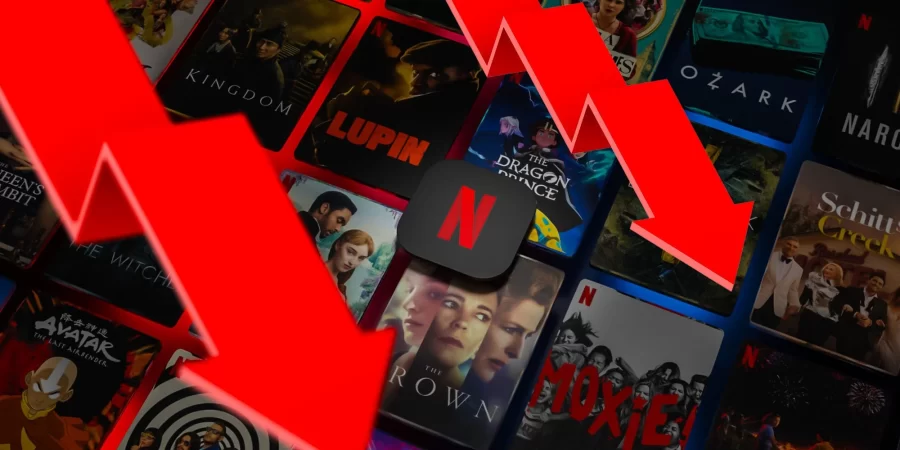Why has the Netflix stock dropped so significantly?
April 26, 2022
Throughout the long-standing legacy of Netflix, the stability of the platform has been questioned many times, but the company has never lost as much as it did approximately a month ago. The streaming service mogul has made substantial progress in its industry since its inception in 1997 and has been seen as a revolutionary in its field, so why (and how) is the company and its prices taking losses in the current day?
The stock price of Netflix peaked during the height of the “Squid Game” popularity trend during the beginning-middle of November in 2021, but ever since the company has only seen drastic losses in its stock price. The price peaked at a stunning number of $678.80 per share, but as soon as the good time for investors rolled in, disaster struck. Freefalling down the financial indexes, Netflix has plummeted an unbelievable 71.53% since November, with 10.70% solely in the last month. As an investor of the stock myself, it’s particularly upsetting to see the stock decline in thirty-five percent of its worth overnight, but the reasons behind it seem even more upsetting for beloved streaming provider Netflix.
After the release of its 2022 Quarter 1 earnings reports, Netflix has revealed some truly horrifying details regarding the future of its company. The document states that throughout the first three months of the current financial year, the company has lost over 200,000 subscribers and even plans to lose up to two million subscribers over the next fiscal quarter. Although the loss in 200,000 subscribers can be seen as a centralized demographic issue within Russia due to the Ukraine conflicts, the succeeding two million sub loss count can only be seen as failure within the Netflix infrastructure to keep its consumers satisfied. The consistent price jumps within the platform’s subscription plans can be especially attributed to this issue of consumer decline. When Netflix first left its DVD delivery system with the past and advanced to an online based streaming service, the cost for the standard two screen emerged at eight dollars. However as the years progressed, there seems to be a platform price hike every year without fail. The most recent price spike took an (already pricey) premium subscription at approximately eighteen dollars to a ridiculous 20 dollar price point. As the subscription continually grows larger and larger in context to its massive video library, the fundamental need for more revenue ultimately will appear, but the way the service is approaching these issues is fundamentally flawed, leading to more harm for their services than good.
Due to these unfortunate customer support issues and terrible internal business decisions, the company has been affected in a multitude of ways.
On top of the consistently declining stock value, the market cap of the business has also taken a massive hit. The market cap, simply put, is the conjunctive value of the company as a whole. As a previous leader within the streaming sector, Netflix used to have a market cap of approximately three hundred billion dollars which has now fallen to about seventy five billion dollars.
Furthermore, the structure of the organization is also being heavily affected and layoffs have already begun. So far, 150 employees have already been fired from the company and the to dwindle costs even further, Netflix will most likely trim its staff to a larger extent.
Now moving onto the biggest and most controversial piece of the puzzle. Netflix is adding ads. How about we just leave that cable for now, Netflix?
The mere idea of ever having advertisements on Netflix would be an almost sinful thought, however, due to the circumstances and the growing competition between streaming services, Netflix has taken the drastic to incorporate a With Ads plan to a lower priced subscription membership. This can be comparable to the basic subscription plan for competitor Hulu. This will give the company much needed revenue through third-party sources, while providing a cheaper plan for people willing to sit through ads to watch their fan favorite TV shows.
Personally, I couldn’t care less about the ad plan. If this supposed plan can keep our loved content on the platform and enables Netflix to be able to create more shows that can keep me entertained, then go for it. But the current issue at hand is that Netflix is looking for solutions to increase revenue, but not satisfy the consumer. I am a huge fan of Netflix and have been since they delivered the first DVD copy of Avatar: The Last Airbender to my doorstep, and it really sucks that a platform that has such an impact on its users, is suffering.
Along with that, due to snowballing circumstances such as a loss of subscriber count and market cap, Netflix is being forced to cut down on the amount of available content for consumers. However even through all of these setbacks, the world’s most popular streaming service is still competing to keep that number one spot through innovations and audience targeted changes, but only time will tell if they remain successful or not.


